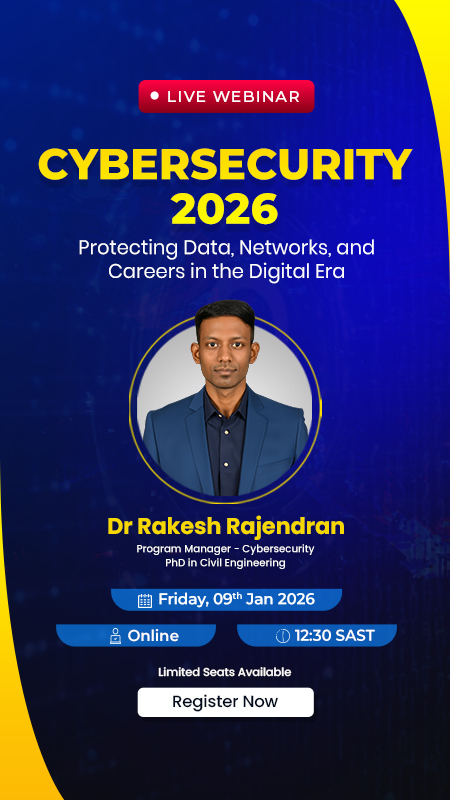Types of Cyber Attacks: Learn How to Protect Your Systems
Cyber attacks are a growing problem for people, businesses, and governments. These attacks are done to steal important information, disrupt work, or demand money. Knowing about the types of cyber attacks can help us spot risks early and take steps to stop them. Attacks like phishing, ransomware, and insider threats work in different ways but can cause serious damage. By understanding these threats, we can improve our security and stay safe from harm.
In this article, we explore the types and how to defend against them, as well as learn about the Cyber Security course by Digital Regenesys.
What is a Cyber Attack?
A cyber attack is when someone tries to harm, steal, or take control of a computer system, network, or data without permission. Hackers use these attacks to cause trouble, steal information, or demand money. Cyber attacks can target individuals, businesses, or even governments. Cyber attacks have become more common as technology advances. Hackers may use different methods, such as phishing or malware, to carry out their attacks. Protecting against these threats requires strong security measures and regular system updates to keep data and operations safe.
Cyber attacks come in many forms, and understanding the types of cyber attacks is essential to staying safe online. Phishing tricks people into giving away their personal information. Malware and ransomware attack computers, locking files until a ransom is paid. Denial-of-service (DoS) attacks overwhelm networks, making them stop working. The goal of these attacks is usually to steal data, disrupt services, or ask for payment. Hackers either take advantage of weak security or trick people with fake messages and emails to carry out these attacks.
Now that you know what a cyber attack is, let us look at the types of cyber attacks in detail.
Get more insights on what is cyber security here.
What are the 10 Most Common Types of Cyber Attacks?
Cyber attacks can target individuals, businesses, or even governments. Understanding the types of cyber attacks helps us protect systems and data from threats. Each attack works uniquely, aiming to steal information, disrupt services, or cause damage. Some attacks, like phishing, trick users into giving away sensitive information, while others, such as ransomware, lock files and demand payment to restore access. Hackers may also exploit weaknesses in software or networks to gain control over systems without detection.
Staying informed about the cyber attack types helps individuals and organisations take preventive measures, such as using strong passwords, installing security updates, and adopting encryption. By understanding how these attacks operate, we can respond more effectively, minimise damage, and maintain the security of our digital environments.
Below are the 10 common types of cyber attacks:
-
Malware
Malware is harmful software designed to damage or disrupt systems, including viruses like worms, spyware, ransomware, and fake programmes like trojans. A trojan looks like safe software but harms the system once installed, while ransomware locks important files and demands money to unlock them. Spyware secretly collects personal data, and adware shows unwanted ads on your screen. Malware spreads through infected email attachments, dangerous links, or infected USB drives. Using antivirus software, firewalls, avoiding suspicious links, and keeping systems updated can help prevent these attacks. Regular system scans and security checks are also essential to detect and remove malware early.
-
Phishing
Phishing is a common type of cyber attack where hackers try to trick people through fake emails. The attacker pretends to be someone trusted and sends a fake message with a harmful link or an attachment. When the victim clicks the link or opens the attachment, the hacker can steal personal information, like passwords or account details. In some cases, the attacker can also install malware on the victim’s device. To prevent phishing attacks, carefully check the emails you receive. Many phishing emails have mistakes in spelling or formatting that look different from real ones. Using an anti-phishing toolbar can help spot suspicious messages. It’s also a good idea to update your passwords regularly to keep your accounts safe.
Learn What is Phishing in Cyber Security Here.
-
Denial of Service (DoS) and Distributed Denial of Service (DDoS) Attacks
A Denial-of-Service (DoS) attack happens when attackers flood a system, server, or network with too much traffic, causing it to slow down or stop working. This makes the system unavailable for real users. If attackers use multiple systems to launch the attack, it is called a Distributed Denial-of-Service (DDoS) attack, which makes it even harder to manage. To prevent DoS attacks, it’s important to regularly monitor traffic to spot unusual activity. Watch for signs like slow networks or sudden website shutdowns and act quickly when they occur. Having a response plan in place ensures your team knows what to do during an attack. Many organisations also rely on cloud-based services to block harmful traffic before it reaches their systems.
-
Man-in-the-Middle (MitM) Attacks
A Man-in-the-Middle (MitM) attack happens when a hacker secretly gets in between two people or systems communicating. The hacker listens to the information being shared and can change it without anyone knowing. This usually happens on unsafe networks, like public Wi-Fi, where users unknowingly connect to a fake network created by the hacker. Through this connection, the hacker can steal sensitive information like passwords or banking details. MitM attacks are hard to detect because everything looks normal to the users. To stay safe, it’s important to use secure networks, encryption, and multi-factor authentication.
-
SQL Injection
SQL injection is a type of cyber attack that targets websites with databases. Hackers insert harmful code into input fields, like search boxes or login forms, to trick the database into running their commands. This allows them to access important information, change or delete data, and sometimes take full control of the system. These attacks are dangerous because they can expose personal or financial data if the website isn’t well protected. Websites can protect against SQL injection by using tools that monitor for suspicious activity and block unauthorised access. Validating and filtering all user inputs ensures that harmful code cannot enter the system. Moreover, keeping software up to date and regularly testing for vulnerabilities helps maintain strong security and reduces the risk of these attacks.
-
Zero-Day Exploit
A zero-day exploit is a type of cyber attack where hackers target a hidden weakness in software that developers haven’t discovered yet. Since no one knows about the flaw, attackers use it to break into systems or steal information before a fix is available. These attacks are dangerous because there are no security patches ready to stop them. Zero-day exploits can cause serious problems, like data breaches or system disruptions. Updating software regularly and using good security practices can help reduce this risk. Identifying and responding to these threats quickly is key to keeping systems safe.
-
Password Attacks
Thistype of cyber attack happens when a hacker tries to guess or crack your password using tools like Aircrack, Cain, or John the Ripper. The goal is to access your accounts without permission. Hackers use different methods, such as brute force attacks that try every possible combination, dictionary attacks that use common words, and keylogger attacks that track what you type. Creating strong passwords with a combination of letters, numbers, and symbols can help keep your accounts secure. It’s important to avoid reusing passwords for multiple accounts and to update them regularly for better protection. Also, keeping password hints private can prevent hackers from guessing your passwords.
-
Cross-Site Scripting (XSS)
Cross-Site Scripting (XSS) is another type of cyber attack where hackers add harmful code to a trusted website or app. When users visit the site, the code runs in their browser without them knowing. This can allow attackers to steal personal information, like passwords, or change the way the site looks or works. XSS is dangerous because it takes advantage of the trust users have in the website. It usually happens when websites don’t properly check or filter what users enter. To prevent XSS, websites need to carefully check all user inputs to block harmful code.
-
Insider Threats
An insider threat happens when someone within a company, like an employee, contractor, or partner, uses their access to harm the organisation. This can be intentional, like stealing data, or unintentional, such as mistakenly sharing confidential information. Since insiders have direct access to important systems, it’s easier for them to get around security. These threats can cause data leaks, financial loss, or damage to the company’s reputation. To prevent this, companies need to track user activities, control access, and train employees on security rules. Spotting problems early and following strict policies can help keep the organisation safe.
-
Ransomware Attacks
A ransomware attack happens when hackers lock or encrypt a person’s or business’s data and demand money to unlock it. If the victim doesn’t pay, the hackers may threaten to delete the data or make it public. Ransomware usually spreads through fake emails, bad software downloads, or weak spots in systems. Once it takes over, it blocks access to important files, causing major disruptions. Paying the ransom doesn’t always guarantee the data will be restored and may lead to more attacks. Regular backups, software updates, and training employees to recognise threats are essential to prevent ransomware attacks.
How to Protect Against Cyber Attacks?
Preventing cyber attacks is important to protect sensitive information and keep systems safe. As cyber threats grow, individuals and businesses must take active steps to defend against them. Good security practices help reduce risks and block unauthorised access to data and networks. Whether it’s updating software or training employees, small actions can make a big difference in staying secure. To better understand these practices, you can enrol in the cyber security course for hands-on learning and practical skills.
Below are some simple ways to prevent different types of cyber attacks.
- Update Software and Systems Regularly – Updating software fixes security issues and protects systems from new threats. Hackers often target outdated programmes, so regular updates are important.
- Create strong passwords & use multi-factor authentication – Strong passwords make it harder for attackers to access accounts. Multi-factor authentication adds extra security by requiring additional steps to confirm identity.
- Provide cyber security training for employees – Training employees helps them spot phishing emails and other threats. Well-trained staff are less likely to make mistakes that could cause security problems.
- Backup data frequently – Regular backups ensure you can recover important data after a ransomware attack or system failure. This reduces downtime and limits the impact of data loss.
- Install & maintain antivirus software and firewalls – Antivirus software removes harmful programmes, while firewalls block unauthorised access to your network. Both are essential for protecting your systems.
- Control access to sensitive data – Limiting access ensures that only trusted individuals can use important information. This lowers the chance of insider threats or accidental misuse.
- Use encryption to protect data – Encryption turns sensitive data into unreadable code. Even if hackers intercept the data, they won’t be able to read it without the key to unlock it.
- Monitor networks for suspicious activity – Regular monitoring helps detect unusual behaviour early. This allows quick action to prevent various types of cyber attacks and minimise damage.
Thus, the increasing number of cyber attacks means that individuals and businesses need to stay alert. Attacks like phishing, ransomware, and insider threats can cause serious problems, such as data loss and financial damage. Knowing how these attacks work and using good security practices like keeping software updated, backing up data, and training employees can help reduce risks. Being prepared and staying informed is the best way to keep your data and systems safe.
Hence you must always stay alert and updated about the various types of cyber attacks. If you want to learn about cyber security, explore the Cyber Security course by Digital Regenesys. The course provides practical learning through flexible learning, designed to equip learners with essential cyber security skills for real-world applications. Visit our website to know more.
FAQs Types of Cyber Attacks
What are the types of attacks in cyber security?
The most common types of attacks in cyber security include phishing, ransomware, malware, and denial-of-service (DoS) attacks. These attacks target data, disrupt operations, or demand payments.
What are the 4 types of cyber attacks to be aware of?
Four common types include phishing, ransomware, malware, and DDoS attacks. Each of these poses unique risks by either stealing information, locking data, or disrupting services.
How can regular monitoring prevent types of cyber attacks?
Regular network monitoring helps detect unusual activity, preventing various types of cyber attacks before they cause damage. Early detection allows quick action to minimise risks.
Why are ransomware attacks among the most dangerous types of cyber attacks?
Ransomware locks critical files and demands payment to unlock them, often causing significant disruptions. These types of cyber attacks can lead to data loss if not handled properly.
How do insider threats differ from other types of attacks in cyber security?
Insider threats involve someone within the organisation misusing their access. Unlike external attacks, these types of attacks in cyber security are harder to detect and prevent.














